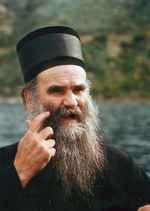 |
Honouring Karadordevic and Karadžic
by Cvijeta Arsenic
The people of Dobrun near Višegrad were enriched last weekend, not by some newly constructed factory to give employment to the impoverished inhabitants of the region, but by a bronze monument to Vožd Karađorđe Petrović, founder of the Karađorđević dynasty. The monument was supposed to be positioned on an elevated spot above the Orthodox monastery graveyard, to celebrate the two-hundredth anniversary of the outbreak of the First Serb Uprising.
The monument, produced by the ‘Braća Radović’ arts workshop in Belgrade, was supposed to be lowered onto its crag with the aid of an RS Army helicopter, but because of its weight (a ton and a half) the helicopter’s engine gave up. Then it was decided to raise the monument manually to its elevated site, but this undertaking failed too. Then they sent an request to SFOR, to allow them to use a Serbian army helicopter of greater capacity, but the request was turned down. The Vožd is for the time being ensconced on a meadow beside the Dobrun monastery.
A procession led by Patriarch Pavle, Metropolitan Nikolaj and other church dignitaries, and by representatives of the present-day power structures on both banks of the Drina - Vojislav Koštunica, [RS president] Dragan Čavić, president of the RS national assembly Dušan Stojičić, [Serb member of the B-H presidency] Borislav Paravac and RS premier Dragan Mikerević - then decided to visit the Dobrun scene. On the bridge built by the Ottoman Empire’s great builder Mehmed-pasha Sokolović, Paravac made a speech in which he appealed to all people of good will to help financially the restoration of a monument that is part of world cultural heritage.
The delegation next set off towards a little bridge funded by an American businessman of Serb origin Slobodan Pavlović, which is likewise declared a significant architectural undertaking. Pavlović was so familiar with the site on which the little bridge is built that he was unable to divine the name of the stream it spanned. He called the river Rzana instead of Rzav, provoking a reaction from a lady standing behind him who kept whispering to him: ‘Rzav, Rzav’. But why should Pavlović be concerned about whether it was Rzav or Rzana, seeing that he is a ‘trans-Atlantic patriot’ who turned up in RS after the war as an investor, not as a humanitarian. This means that Pavlović always calculates that his investment must produce a twofold or threefold return. For example, he has already had an ample return on the money he put into the Pavlović bridge near Bijeljina, by charging for tickets to cross over it.
The RS delegation went for a boat-ride too, on the artificial lake of the Višegrad hydro-electric station, and also made its way to the town’s House of Culture, where things were more than interesting. To the surprise of associates of Milorad Dodik (and others), the RS police chief Radomir Njeguš - who recently sent Dodik an official letter asking him to present himself for questioning at MUP headquarters - went up to the SNSD leader and greeted him warmly. From somewhere there popped up also the former B-H Presidency member Mirko Š arović and his crony Slavko Tošović (the suspended mayor of Serb New Sarajevo municipality, suspected of being part of the network of support for Radovan Karadžić), who likewise buttonholed Dodik. The SNSD leader politely excused himself and went off to visit the fifty-odd unfortunates in the Višegrad refugee settlement, whom God himself has forgotten about.
The Dobrun festivities; suppers with gusle music at Š ula in honour of Radovan Karadžić; the organization of a dinner entitled ‘Contribution to the Truth’ at Medun near Podgorica (also in honour of Radovan Karadžić, where the guests included Luka Karadžić, Bishop Amfilohije Radović, the poet Rajko Petrov Nogo, the painter Nikola Kusovac and others from the International Council for Truth about Radovan Karadžić) - all these are really part of a nationalist political campaign launched by the Serbian Orthodox Church. ‘Those who are ready to die for their guts, and not for the holy cross and golden freedom, do not belong to the Montenegrin people, but to the people of gut-worshippers’ -

this was the message addressed by Bishop Amfilohije from the Medun gathering to all ‘gut-worshippers’ on both sides of the Drina, meaning for some strange reason particularly the Montenegrins.
This report has been translated from Dani (Sarajevo), 3 September 2004
|